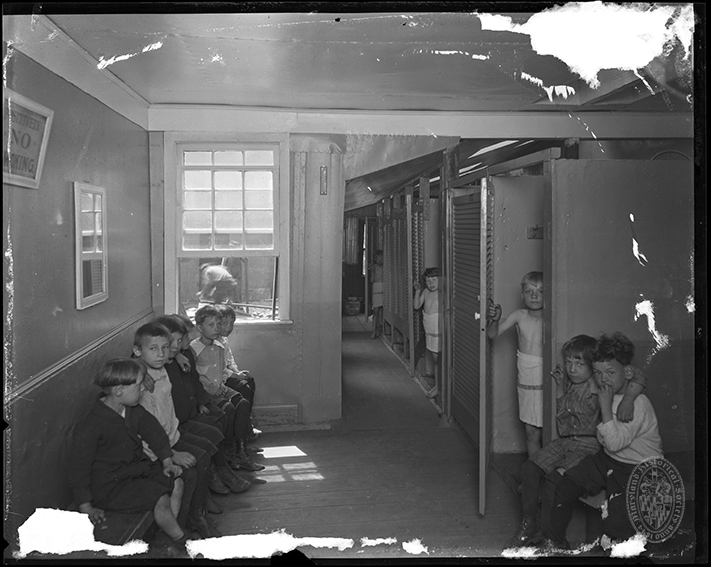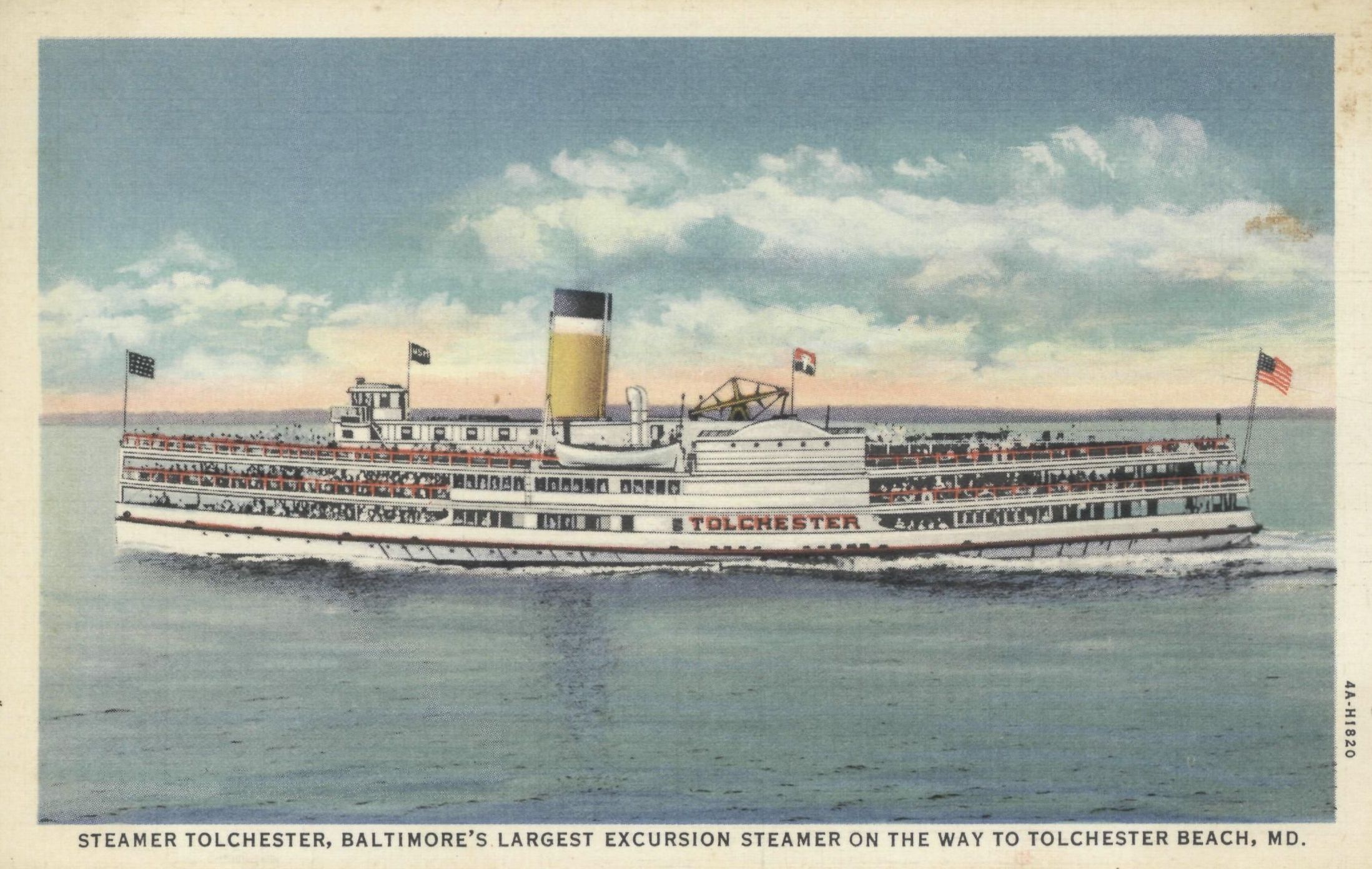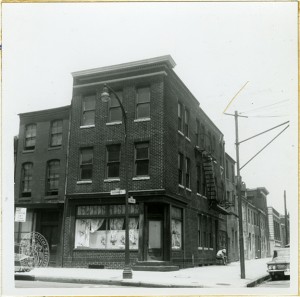Growing Up in Fell’s Point: More Jennie Sokolowska Stories
The previous installment of this series appeared on December 15, 2016.
Jane Schoeberlein (1924-2014), known as Jennie Sokolowska in her youth, was the daughter of Polish immigrants of limited means. She spent her childhood and early adult life in the Fell’s Point area of East Baltimore. Here are a few of her stories that touch upon Summer and her early jobs.
A Summer Outing

Pratt Street, Pier 16, Tolchester Company Excursions Pier. February 1929, BCLM Collection, MC6641, MdHS.
One summer day Jennie and her three sisters enjoyed a free, special trip provided through a local charity. Organizations like the “Fresh Air Fund” provided the opportunity for the city’s poor children to spend time away from the hot city streets to enjoy a carefree day out in the country.(1) These charity-sponsored trips usually involved a boat ride. Several pleasure beaches dotted the shores of the Chesapeake Bay and city residents could reach them through daily boat excursions departing from the what is known today as the “Inner Harbor.” Tolchester Beach, one of the more popular destinations, featured places for swimming and sunning, as well as rides, a bandstand, a dance hall, and a casino.
The dawn broke bright and the sky was cloudless on that big day. Stella, her mother, rode the streetcar with Jennie and her sisters all the way down to Pier 16 on Light Street that morning, the brilliant sunshine reflecting like diamonds upon the gentle ripples of the water. Arriving at the boat, most likely “The Tolchester,” the girls quickly scrambled up the gangplank and lined up at the deck rail near the bow.
Excited by the big adventure about to take place, the girls chattered among themselves, their heads darting here and there as they took in the sights of the bustling port. Jennie then shot a glance toward her mother down below on the dock where she stood. Looking up at them with just the slightest of smiles on her lips, one solitary tear, soon followed by others, streamed slowly down her cheeks.
Pulling out a lacey hankie from her purse, her mom dabbed her eyes with the delicate white cloth. Jennie was confused and did not understand the reason behind her mother’s crying. Were they tears of joy, knowing that her girls were going to have a good time, an experience that was normally beyond their family’s means? Was her mother’s joy mixed with sorrow, knowing that she would be parted from her precious girls, who all meant so much to her? As the lines were removed from the dock pilings and the boat slowly moved away, her Mom’s sobbing grew even stronger as she feebly waved them goodbye. It’s hard to say what brought forth the strong emotions. Jennie, reflecting upon the scene years later, believed that the boat voyage may have reminded her mother of her own departure from her family, a separation made complete by distance and time, and it was this that tugged on her heart strings.
The Working World
Jennie’s first taste of work came on a complete whim. One summer, the whole family traveled out to “the country,” probably northern Anne Arundel County, to pick vegetables. Polish immigrants, many living in Fell’s Point, had been recruited for this task for decades. According to Jennie, the children “begged” their parents to go since their friends and neighbors had previously done such work. Now the kids wanted the same opportunity to earn a little money and be out in the open air.(2)
Very primitive living conditions awaited them at the farm. Assigned a tumbled-down, dirt-floored, one-room shanty to themselves, the whole family shared a straw-stuffed bed. In actuality, it was less of a bed and more of canvas bag plunked down upon a very large platform attached to the wall and barely supported by two rickety legs. A rough-hewn picnic bench that sat outside served as the dining table. Not even an outhouse graced the site. The farmer, however, did provide an old, dented-up bucket for personal relief—to be used outside. One night, Jennie, with bucket in hand, left the shanty to use it within the privacy of shrubs nearby. Pandemonium soon broke out as both her family and the others in the neighboring shanties awoke suddenly to the sound of bloodcurdling cries. In that almost moonless, hazy night, Jennie thought she saw a ghost out in the distance and immediately started screaming. For all we know, it may have just been one of the nightshirt-wearing neighbors also outside to answer Nature’s call. After her parents made sure that everything was all right with Jennie, and calm was restored once again, the family decided on an “inside plumbing” set-up. Jennie could now go with her bucket to a nearby shed just steps from their shanty. Despite the hard work and the minor trauma, the family made little money during their time away.
Once while out in the country, Jennie went walking along a dirt road with a group of children. Their stroll took them through some apple trees. It was harvest time and the sight and smell of the ripe red fruit, just hanging overhead, was just too much for the kids to resist. A tall boy was able to reach up and grab hold to the end of a heavily laden branch and give it a good shake, unleashing a cascade of fruit. The group scrambled quickly to pick up the apples. Yet, the enjoyment of that first crisp, juicy bite was short-lived as the farmer, who lived nearby, saw them and came running at full speed. The children all scattered with the exception of Jennie. Was she caught off guard? Did she feel she not have to run because she had not been eating the fruit? The farmer came right up to Jennie. Towering over her, his gaunt, red cheeks huffing and puffing, he snatched an apple from the tree and shoved it directly in front of her face saying angrily, “You wanna an apple? You wanna an apple? Here, eat an apple.” “Oh, he had such a mean and ugly face,” she would recall even decades later. Shaking her head “no,” Jennie refused the farmer’s apple. He had really frightened her and her eyes welled up and then tears began to flow. Turning her back to him, she slowly walked down the dirt road, all alone, sobbing quietly the whole way.
Jennie was only fifteen when she started her first regular job. She was hired to clean the house belonging to the William S. Hart Family at 1744 Aliceanna Street, just a few blocks over from her own home. The Hart’s had a higher social standing than her own family due to their education and refinement, and Jennie’s exposure to them broadened her own world view. Mr. William, the father, was a Johns Hopkins University graduate and worked as a lawyer. Mrs. Isabella, the mother, was a Polish immigrant, a graduate of the Peabody Institute in piano and a worker among the foreign-born.(3) Their only child, William, Jr., another Peabody graduate, was a talented musician who played percussion with the Baltimore Symphony Orchestra in the 1940s.(4) The widowed grandmother, Mrs. Teresa, Isabella’s mother, was a dressmaker by profession and may have taught Jennie how to sew and how to crochet, the latter a popular pastime with Polish women and their daughters at this time. Jennie’s duties included scrubbing the front stoop, dusting, cleaning the kitchen and bathroom, and mopping the floors of the home on a regular basis. She also ate some her meals there, often being rewarded with samplings of exotic foods, previously unknown to her. Here is where she tasted her first apricot, a flavor she relished and an occasion that she would often later recount. Jennie was treated well and always recalled her time with the Harts with great fondness.

Public Baths, interior, 1323 Eastern Avenue, April 29, 1922, Baltimore City Life Museum Collection, MC6414.1, MdHS.
Incident at the Public Baths

Public Baths, 1521-1529 Eastern Avenue, 1926-1927, Baltimore City Buildings Photograph Collection, PP236.001A, MdHS.
Jennie’s Shakespeare Street home, along with many others in Fell’s Point, did not feature a specialized room for bathing. Baltimore City, a few decades earlier, had embarked upon a building campaign to erect Public Baths to improve the general quality of life for its citizens and promote better personal hygiene among the immigrant classes and the poor.
Jennie was fortunate to live just a short walk to a public bath located on the corner of Bond Street and Eastern Avenue. The Eastern Avenue Baths consisted of three good-sized rowhouses, renovated and connected to one another, all re-fitted with individual shower rooms featuring floor to almost ceiling curtains for added privacy. The space inside each room was large enough to stow your clothing on pegs outside the shower stall. For five cents you got a towel and a small bar of soap.
One day when Jennie was showering someone opened the curtain of her shower room and helped themselves to her almost new pair of tennis shoes. Now, shoes of any kind were a dear possession, more so for those families of limited means financially squeezed by the Depression. With her hair and body still dripping, she folded back the shower curtain to get her towel and immediately noticed that her shoes were gone. It must be some mistake, she told herself. Drying off and dressing herself hurriedly, she went to the matron to tell her about the missing shoes but the woman said saw nothing and could not help her.
Jennie’s initial panic soon gave way fear and dread as she started to anticipate what would happen when she got home. What would her mother say, or, perhaps, do to her? To add insult to injury, Jennie had to face the embarrassment of walking home barefooted, from what I gather, an unusual sight and especially humiliating for a youngster of her age. She got yelled at good by her mom, telling her “you be more careful next time.” Jennie made sure to go from now on with a sister or a girlfriend and take turns—one shower while the other watched over their belongings.
(Robert W. Schoeberlein)
Dr. Robert W. Schoeberlein is the Acting Baltimore City Archivist.
Sources and further reading:
(1) I cannot determine what organization or agency organized this event. The City organized a yearly trip for the “poor” on an old fire boat berthed in Fell’s Point. Jennie’s trip and the boat were both different than this one.
(2) Polish immigrants and their children living in Fell’s Point had been recruited specifically for this type of work since the early 1900s. Lewis Hines documented their labor in his 1908 photographs. Hines images show immigrants being gathered and placed on horse drawn wagons for transport to the farms, working out in the fields, along with interior and exterior shots of their shanties.
(3) See the Sun, September 12, 1923 for the background of William and Isabella Hart.
(4) Sun, June 1, 1939. “Junior” won prizes at Peabody. He was nicknamed “Babe-bush.”




